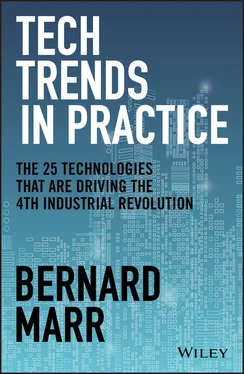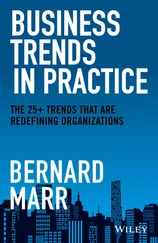The better you understand your customers, the better you can serve them. Sales and marketing activity is often based on past sales history – effectively, which customers previously bought which products or services. But, thanks to big data and augmented analytics, this activity is increasingly becoming more predictive. In other words, companies are now confidently and accurately anticipating what customers will want in the future. Netflix predicting what you might want to watch next is one simple example of this.
In another example, German retail company Otto discovered that customers are less likely to return items when they arrive within two days, and when they receive all their items at once, rather than in multiple shipments. Hardly earth shattering – keeping goods in stock and shipping efficiently makes good sense. However, Otto is like Amazon in that it sells products from many, many brands, which means stocking and shipping products all at once is a major challenge. So Otto analyzed the data from 3 billion past transactions, plus factors like weather data, to build a model that could predict what customers would want to buy in the next 30 days. Not only could the system do this, it could do so with 90% accuracy. 6Now, the company can order the right products ahead of time and, as a result, product returns have been reduced by over 2 million items a year.
Delivering More Intelligent Products and Services
When you know more about your customers, you can give them exactly what they want: smarter products and services that respond intelligently to their needs. This has given rise to a wealth of smart products, such as smart speakers, smart watches, even smart lawnmowers. For plenty of examples of smart products and services in action, circle back to Trends 2 (IoT) and 3 (wearables), or turn to Trend 18 (digital platforms).
Improving Internal Operations
Every business process and every aspect of business operations can be streamlined and enhanced, thanks to big data. Optimizing pricing, accurately forecasting demand, reducing employee turnover, boosting productivity, strengthening the supply chain – across all areas of the business, it’s easier than ever to make improvements, generate efficiencies, save money, automate processes, and more.
Remember the Otto example of predicting demand in order to improve stock ordering? Thanks to data (and more than a bit of AI, see Trend 1), this impressive process happens automatically. The company’s system orders around 200,000 products a month without human intervention.
In another example, Bank of America worked with Humanyze (formerly Sociometric Solutions) to implement smart employee name badges, fitted with sensors that can detect social dynamics in the workplace. From the data generated, the bank noticed that top-performing employees at call centers were those who took breaks together. As a result, it instituted new group break policies and performance improved 23%. 7You can find more examples of enhanced and automated business processes in Trend 13 (robots and cobots).
Creating Additional Revenue
Optimizing business processes, making better business decisions, and so on, will no doubt have a positive impact on the bottom line. But the link between data and the bottom line can be much more explicit, meaning data can be monetized to create new revenue streams.
This may encompass bringing new data-driven products to market (such as the smart products outlined in Trends 2 and 3), or it could mean actively selling data through optimized services (such as Google’s data-driven advertising offering). Data can even increase the value of a company; at the time of writing, the world’s top three most valuable brands were Google, Apple, and Amazon – each of them data-driven businesses. 8
You might think that some of the most obvious challenges around big data are the technology, infrastructure, and skills challenges. To put it another way, do you have to have the budget, infrastructure, and know-how of, say, Google or Amazon to benefit from big data? Thanks to augmented analytics and big-data-as-a-service (BDaaS), the answer is no. I’ve covered augmented analytics earlier in the chapter, so let’s briefly look at BDaaS. The term refers to the delivery of big data tools and technology – and potentially even data itself – through software-as-a-service platforms. These services allow companies to access big data tools without the need for expensive infrastructure investments (see also AI-as-a-service in Trend 1), thereby helping to make big data accessible to even small businesses. This also helps to overcome the massive skills gap in big data. Essentially, there aren’t enough data scientists to go around; the McKinsey Global Institute predicts that, by 2024, there’ll be a shortage of approximately 250,000 data scientists – and that’s just in the US. 9
As analytics tools advance, my hope is that technology, infrastructure, and skills will become less daunting barriers to working with data. But that doesn’t mean there won’t be other barriers to contend with. I believe two of the biggest challenges around big data are data security and privacy.
Ever-growing volumes of data – and the fact that data is becoming more of a critical business asset – brings huge challenges in terms of protecting that data. It’s therefore vital that organizations take steps to protect their data from attack, particularly when it comes to personal data (like customer or employee data). Advances like the IoT add an extra dimension to the threat, since many connected devices are totally unsecured, thereby providing a potential way in for hackers. (One study has found that 82% of organizations believe that unsecured IoT devices will cause a data breach in the next few years. 10) But your employees are another significant threat to consider. So as well as having a robust data security policy in place, it’s vital you raise awareness of the potential threats and educate your teams on the need to protect data.
Security is closely linked to data privacy, since so much of the data that organizations are working with contains personally identifiable information. Regulators are, to some extent, still playing catchup when it comes to data privacy laws, but that will change. Recent GDPR guidance in Europe is designed to promote the safe and ethical handling of personal data – and give individuals a greater say in how organizations use their data. Therefore, it’s not enough to protect your data securely – you also need to take an ethical approach to collecting and using that data. This means being completely transparent, making customers and other stakeholders aware of what data you’re gathering and why, and giving them the chance to opt out where possible. Those companies who don’t comply with tightening regulation, or who play fast and loose with people’s data, risk serious financial and reputational blowback in the future.
How to Prepare for This Trend
Despite the challenges, most experts, myself included, believe the benefits of big data are huge. Data can bring enormous value to your organization, providing you prepare properly. For me, this means:
Improving data literacy across the organization
Creating a data strategy
Let’s look at each step in turn.
Improving Data Literacy Across the Organization
The more data literate your organization is, the better your results will be. It’s as simple as that. But that doesn’t mean everyone has to be a data scientist. It simply means that everyone right across the business must be comfortable with data: talking about data, using data, thinking critically about data, pulling meaningful insights from data, and ultimately acting on what data tells them. Data literacy is about everyone putting data to use, essentially.
Читать дальше












